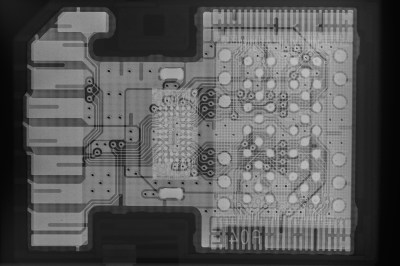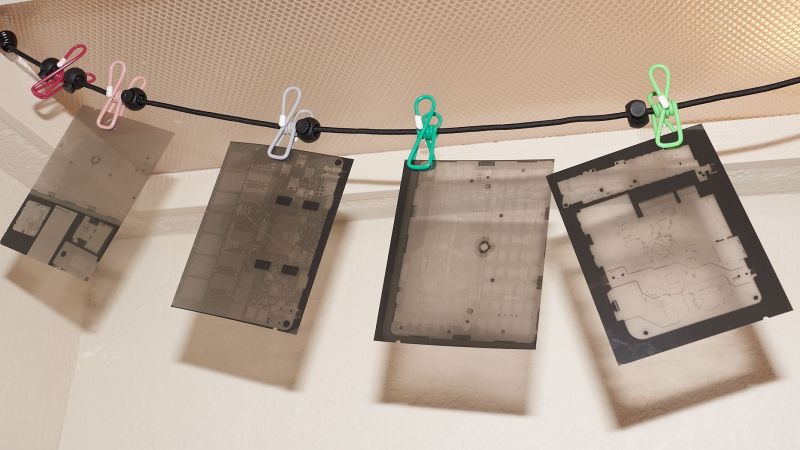In the same way that a doctor often needs to take a non-destructive look inside a patient to diagnose a problem, those who seek to reverse engineer electronic systems can greatly benefit from the power of X-ray vision. The trouble is that X-ray cabinets designed for electronics are hideously expensive, even on the secondary market. Unless, of course, their sensors are kaput, in which case they’re not of much use. Or are they?
[Aleksandar Nikolic] and [Travis Goodspeed] strongly disagree, to the point that they dedicated a lot of work documenting how they capture X-ray images on plain old analog film. Of course, this is nothing new — [Wilhelm Konrad Roentgen] showed that photographic emulsions are sensitive to “X-light” all the way back in the 1890s, and film was the de facto image sensor for radiography up until the turn of this century. But CMOS sensors have muscled their way into film’s turf, to the point where traditional silver nitrate emulsions and wet processing of radiographic films, clinical and otherwise, are nearly things of the past.

Luckily, though, [Aleksandar] and [Travis] happened upon a small X-ray cabinet whose sensor had given up the ghost, forcing them to improvise. The first pass was with plain black-and-white film, Ilford Ortho Plus to be precise. The 4×5 format film was just the right size to substitute for the wonky image sensor, and at ISO 80 was fine-grained enough to capture the details needed for reverse engineering. After 3D-printing some film holders — PETG proved to be more radiolucent than PLA for some reason — they took some long exposures of various devices in their X-ray cabinet.
The film was processed with the standard chemicals, and the results were pretty fantastic. For those opposed to the wet work, they also tried using instant film packs like those used in Polaroid and Fuji Instax cameras. After removing a single piece of film from a pack inside a dark bag and sensitizing it with a quick flash of visible light, they were able to expose the film and re-insert it into an empty film pack. Slapping the pack back in the instant camera ejects the film, squeezing out the chemical and developing the picture. Et voilà, instant X-rays.
We’ve got to say that this is pretty fantastic work, and we love that this perhaps makes a valuable reverse engineering tool a little more accessible to the average hacker. [Aleksandar] and [Travis] presented this work at Schmoocon a couple of weeks back; the entire track of talks was streamed live, but luckily their talk is at the very beginning of the long video below.
Thanks to [FuzzyAleks] for the tip

















Fabulous work. Would love to do this; I’m still using 4×5 film (Ilford Ortho Plus) and have a Intrepid camera and a load of film holders at my disposal. No idea where I’d get a knackered x-ray cabinet though…
I’ve had good success just putting ordinary Ilford multigrade paper into a LANEX Fast film cassette. It yields a direct-to-print x-ray photograph. Works great. Not crazy exposure factors compared to film too, which is rather surprising. (don’t run that cassette with the paper through the automated developer though!).
I’d post an example, but it’s not obvious to me how to embed an image here from a local file.
AIUI, you need to have the photo(s) on a public site such as snapshot for them to be inserted into a comment.
Or, expose your personal files to the Internet via an in-house server.
Those cassettes usually have intensifying screens (sheet of paper that fluoresces green when hit with x-rays) which benefits film sensitivity. It affects image quality, though. Still very usable, except when you want really sharp images (like the SD card example).
*ALL* these (clinical) x-ray cassettes have intensifier screens. LANEX (and Min-R) is green. Most are actually blue-violet to better match older orthochromatic film responsivities. As for ‘quality’, Signal:noise of a screen-film x-ray image can be much greater than film-only. Resolution of bare film is much better than a screen: 100-150 lp/mm vs 5-10 lp/mm, but that resolution can rarely be realized due to noise.
They’re for different applications. Need high resolution, willing to tolerate high noise, long exposures and high dose to the subject? Use direct film. Need low noise, fast exposures, or low radiation damage to the subject? Or have a x-ray tube with a small focal spot that can support geometric magnification? Use a screen.
The instant X-rays via Polaroid and Fuji Instax camera film does sound very interesting.
The need to pre-sensitize and then use the camera to squish the film sounds ungainly though.
The mechanism can’t be that complicated, maybe he could 3D print a film squisher?
I’ve looked into building a 3D-printed Instax-camera. It’s really not that simple. The rollers needs to have the exact dimensions and pressure for the spreading to happen correctly. Easiest way is to steal the rollers from a broken/used camera.
I take it that this photographic paper is much cheaper than X-ray film?
Sounds like how my dental x-rays used to work
Except they had a specific machine they put the exposed xray film in, out come develop pictures
Now it just shows up on the Lan thru da computer
Much easier than messing with film -use an intensifying plate from a cassette, and a digital camera. Use a 45 degree mirror to keep the camera out of the path of the x-rays.
Don’t forget it should be a front-surface mirror. And bonus points if the camera is monochrome (no Bayer mosaic filter) — doubles the resolution and triples the sensitivity.
Or if you’re hardcore, you can use the camera’s sensor to detect x-rays directly, and get <10 micron resolution. It's pretty noisy, and only really has useful sensitivity around 10 keV photons: Lower energy ones get stopped by the glass window, and higher energy ones are too penetrating: they zip through and don't deposit much signal in the sensor.
If you're *really* hardcore, you remove the window and deposit scintillator material directly on the CCD.